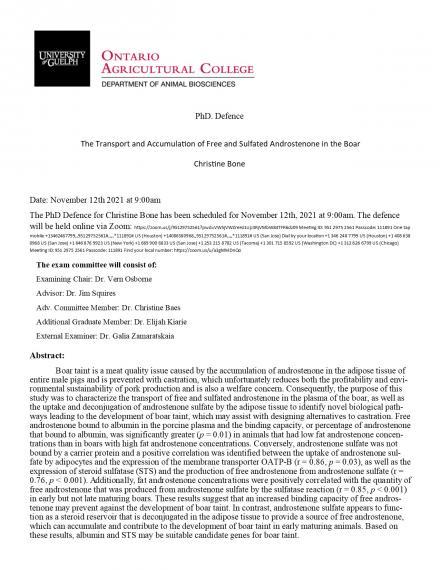Christine Bone's PhD Defence
Date and Time
Location

Details
Boar taint is a meat quality issue caused by the accumulation of androstenone in the adipose tissue of entire male pigs and is prevented with castration, which unfortunately reduces both the profitability and envi-ronmental sustainability of pork production and is also a welfare concern. Consequently, the purpose of this study was to characterize the transport of free and sulfated androstenone in the plasma of the boar, as well as the uptake and deconjugation of androstenone sulfate by the adipose tissue to identify novel biological path-ways leading to the development of boar taint, which may assist with designing alternatives to castration. Free androstenone bound to albumin in the porcine plasma and the binding capacity, or percentage of androstenone that bound to albumin, was significantly greater (p = 0.01) in animals that had low fat androstenone concen-trations than in boars with high fat androstenone concentrations. Conversely, androstenone sulfate was not bound by a carrier protein and a positive correlation was identified between the uptake of androstenone sul-fate by adipocytes and the expression of the membrane transporter OATP-B (r = 0.86, p = 0.03), as well as the expression of steroid sulfatase (STS) and the production of free androstenone from androstenone sulfate (r = 0.76, p < 0.001). Additionally, fat androstenone concentrations were positively correlated with the quantity of free androstenone that was produced from androstenone sulfate by the sulfatase reaction (r = 0.85, p < 0.001) in early but not late maturing boars. These results suggest that an increased binding capacity of free andros-tenone may prevent against the development of boar taint. In contrast, androstenone sulfate appears to func-tion as a steroid reservoir that is deconjugated in the adipose tissue to provide a source of free androstenone, which can accumulate and contribute to the development of boar taint in early maturing animals. Based on these results, albumin and STS may be suitable candidate genes for boar taint.